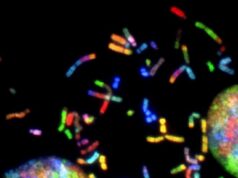Photo and sketch of the confiscated specimen showing three different juveniles of the same species of dinosaur preserved in roosting posture, immediately next to each other.
Credit: Gregory Funston
The Mongolian Desert has been known for decades for its amazing array of dinosaurs, immaculately preserved in incredible detail and in associations that give exceedingly rare glimpses at behavior in the fossil record. New remains from this region suggest an entirely unknown behavior for bird-like dinosaurs about 70 million years ago. At least some dinosaurs likely roosted together to sleep, quite possibly as a family, much like many modern birds do today. Gregory Funston, Ph.D. Candidate at the University of Alberta, will present the team’s research findings at the annual meeting of the Society of Vertebrate Paleontology, held this year in Calgary, Alberta (Canada) on Friday, Aug. 25th.
The three juvenile oviraptors had several features that indicated they belonged to a whole new species. Other fossils found in Mongolia also seem to belong to this new species, and further flesh out the life history of these animals. The notable head crest is present even at a young age, but the dinosaurs would have had gradually shorter tails as they aged, and some of their bones fused across their lifetime. Their head crests and tails have been argued to represent sexual display features used in mating, somewhat similar to modern peacocks or turkeys. Funston added “The origins of communal roosting in birds are still debated, so this specimen will provide valuable information on roosting habits in bird-line theropods.”
Story Source: Materials provided by Society of Vertebrate Paleontology Original written by Whitney Clavin.Note: Content may be edited for style and length.











